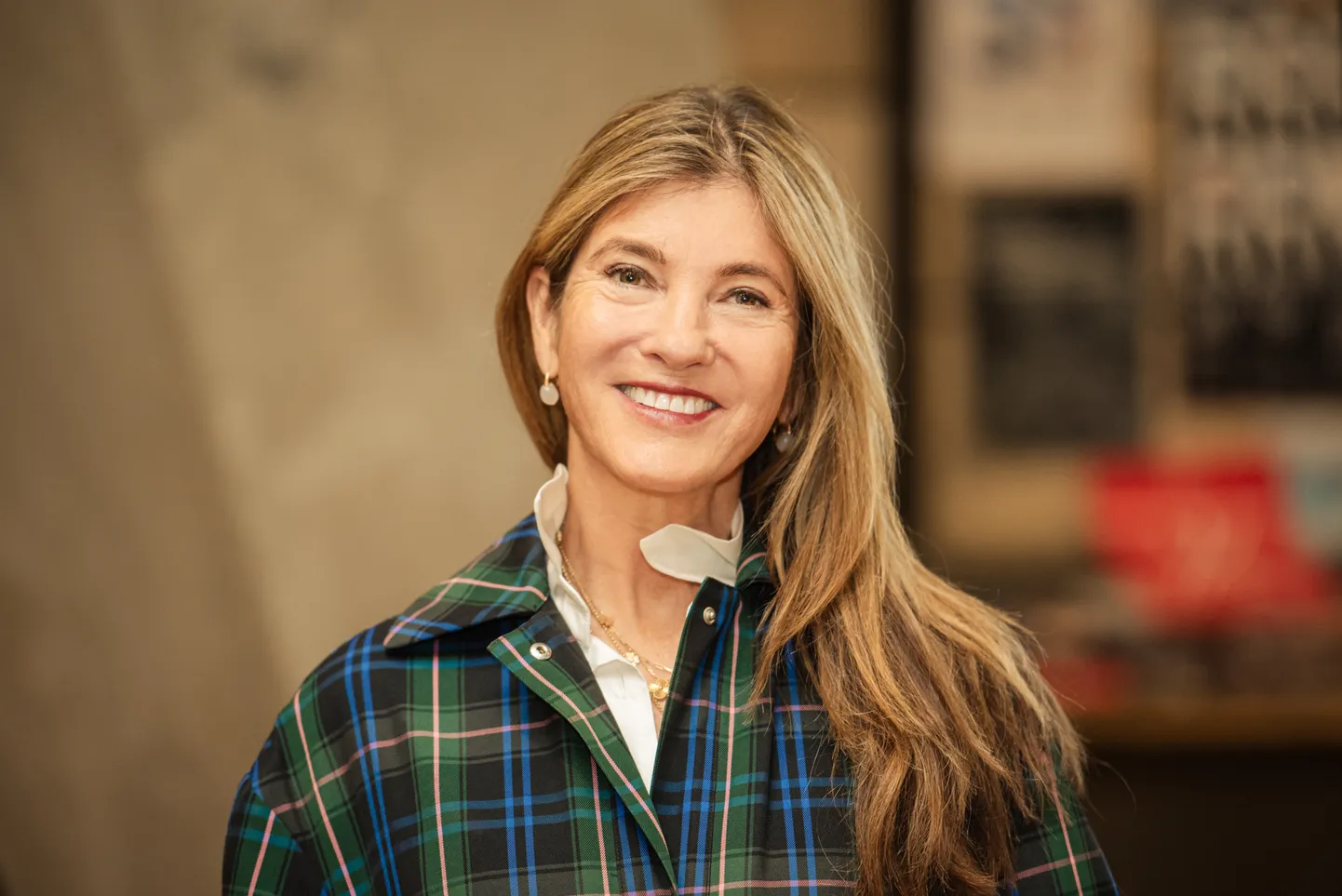Established in 2025, the Linstow Art Award (LAA) is a collaboration between Linstow Baltic, a leading real estate developer in the Baltics, and the Art Academy of Latvia. The initiative is designed to provide a contemporary platform for emerging Latvian artists to launch and develop their professional careers. The award forms an integral part of Linstow Baltic’s long-term sustainability strategy, which seeks to unite art and business in fostering talent and shaping vibrant, creative urban environments.
The mission of the Linstow Art Award is to give long-term support to young Latvian artists, ensuring a stronger art community and a lasting presence of art in the city. The three winners will each receive a monetary award of €3,000 (net) and one year of access to an art studio (25kvm) at the creative SPORTA2 quarter in Riga, long with the opportunity to exhibit artworks.
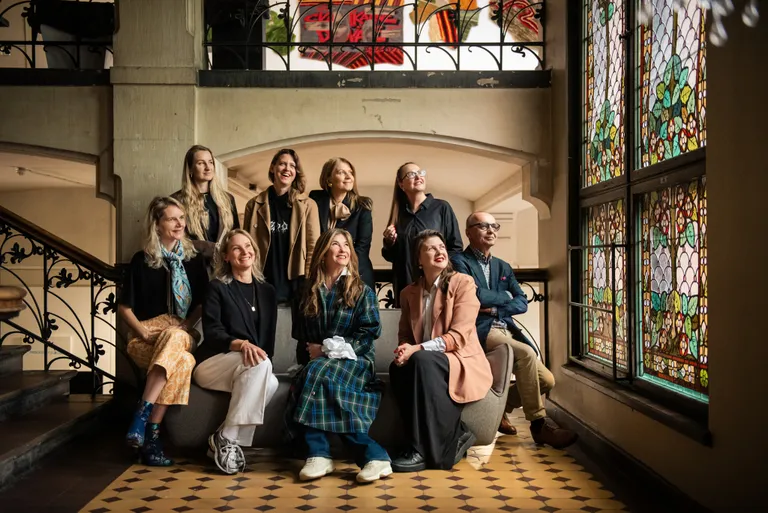
Paulina Rider Vilhelmsen with the international jury of the Linstow Art Award, the Rector of the Art Academy of Latvia Kristaps Zariņš, the Vice-Rector Antris Priedis and the organisers. PHOTO: IEVA MAKARE
This year marks the inaugural edition of the LAA, and the response has been remarkable—over 60 applications were submitted by recent master’s program graduates. The exceptionally high level of interest confirms both the need for such an award and its strong recognition and appreciation among emerging artists.
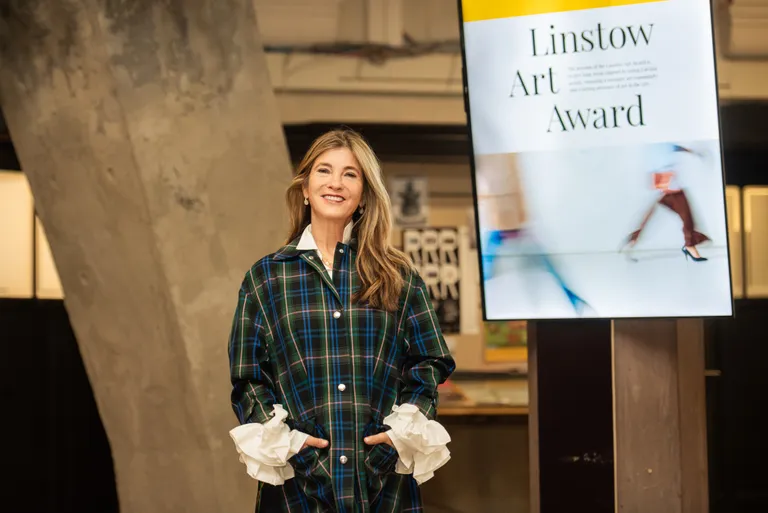
“The time after graduation is one of the most difficult, because young artists have a lot of potential, but often lack support mechanisms,” says Paulina Rider Wilhelmsen. PHOTO: IEVA MAKARE
Therefore, we invited Paulina Rider Wilhelmsen for an interview – the founder of the Linstow Art Award and the Lise Wilhelmsen Art Award. She is a philanthropist, art patron, art collector, and producer, whose long-standing commitment to supporting contemporary art and emerging artists has made a lasting impact on the international art scene. In this conversation, she shares her vision behind establishing the LAA, the importance of supporting young talent, and how art and business can come together to enrich urban life and cultural identity.
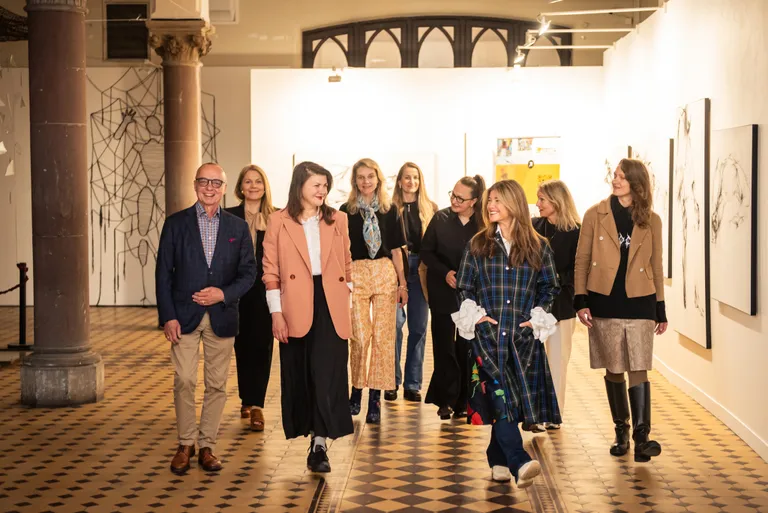
Paulina Rider Wilhelmsen with the international jury of the Linstow Art Award, the Rector of the Art Academy of Latvia Kristaps Zariņš, the Vice-Rector Antra Priede and the organisers. PHOTO: IEVA MAKARE
What inspired you personally to create the Linstow Art Award supporting young artists? What is the aim of this scholarship program?
I’ve been supporting the arts for decades, both personally and through our family business, which has had a presence in Latvia for 29 years. During a recent visit, I saw the new project that Linstow was developing, and the area’s rich history struck me – I was told it’s traditionally been an area where the creative people gathered, and I believe there is a gallery there. Therefore Linstow has been interested in keeping this vibe alive. That resonated with me.
In everything we do, both on the business side and in our impact investments long term, we are guided by a strong commitment to listening to local communities in places we engage. My family and I try not to approach projects superficially; we prefer to invest time and intention in connecting deeply with the culture and people. Our philosophy is about making long-term commitments and becoming part of the community, not just arriving from the outside and then leaving again.
The Linstow director mentioned a desire to involve artists in the process, and that conversation stayed with me. I’m part of the International Council at Tate, and I reached out to a fellow member, Vita Liberte, who is originally from Riga. I asked her, “What is the situation for young artists in Latvia right now? What would be the most helpful if we were to consider supporting a program here?”
She explained what many of us already know – that globally, investment in the arts is often the first to be cut. And in Latvia, while the Art Academy of Latvia is excellent, many of young artists struggle to continue their practice once they graduate. There’s a real need for support, not just for recognition, but for the basic ability to keep working and evolving.
That’s where the idea was born: to create something that supports young artists here, at a grassroots level. I believe that nurturing a strong artist community is essential to building a vibrant city. And I know that when Linstow works on a project, they go far beyond the business side. Their approach is rooted in design, creativity, and collaboration — values that align deeply with ours.
From the first time I came to Latvia, I was impressed by the intellectual curiosity and cultural depth here: how much people read, how engaged they are with ideas and the arts. I remember conversations with students about Henrik Ibsen, and they knew more than I did. It was inspiring.
While this reflection has been long, it comes from a place of genuine admiration and hope. I truly believe there’s a unique opportunity here to bring people together, support emerging talent, and help shape a sustainable and creative future for young Latvian artists. I also aim to bridge the gap between Scandinavian curators and the Baltic region. Connecting these two parts of the world could bring about significant positive changes, and it could be beneficial from a social enterprise perspective. And I’m excited to be part of this journey.
How do you view the role of young artists in shaping Latvian culture and its visual, public, and environmental spheres?
I was really excited to see how socially and environmentally conscious many of the Linstow Art Award applicants were. To me, it’s clear that a shift is happening and I see that many artists’ ideas are becoming more about collective ideas and practices that serve the greater good. Earlier I often felt that art could feel very excluding, especially in museums, where if you didn’t have a certain academic background, it could be hard to access the meaning of the work.
Feels like it was uniquely for people with master’s degrees…
Yes, indeed. Now, there’s more emphasis on communication, inclusion, and accessibility. I’ve always been drawn to social activist art, and I’m inspired by how many young artists are embracing that, creating work that connects across boundaries and encourages dialogue. It’s not only just about individual expression anymore; it’s about integration, history, and reevaluating what counts as ‘art’, for instance, like how textile or craft-based practices are being taken more seriously.
Even museums and institutions, which used to feel reserved for a specific elite group, are becoming more open and engaging with broader audiences. I see all of this reflected in the applicants I’ve reviewed recently—it’s a hopeful and dynamic shift
Why do you think it’s important to support these young artists at the beginning of their careers, just when they’re growing?
I think it’s quite obvious. Coming straight out of the academy is a challenging moment—they’re full of potential but often lacking support structures. I’ve been incredibly impressed by the level of education and maturity I’ve seen in these students, especially their ability to communicate about their work, even in English. That says a lot about the quality of their training.
This project is a long-term commitment for us. Ideally, it will outlast me. We’re aiming to build not just a grant, but a network—a living community of awardees who can support each other, mentor newer artists, and grow together.
Maybe an alumni program?
That would be the aim, yes! With three awardees each year, I hope it evolves into something lasting: an alumni network, a support system, and a foundation for deeper artistic roots in Latvia.
I think I already know the answer, but as an art patron, what does the Latvian Academy of Arts Award mean to you? Is it an investment, a responsibility, or a matter of the heart?
For me, it always starts with the heart. I’m very passionate—if I believe in something, I go all in. When I saw the level of the applicants, I was genuinely over the moon. I didn’t know what to expect, but the quality was so high, I could’ve chosen almost every one of them. It was incredibly inspiring.
Beyond passion, I also feel a deep sense of responsibility. Coming from a family with means, I believe we have a duty to contribute to the greater good. That sense of collective responsibility is something I carry with me, especially in my role as a patron. If you have the ability to help, I think you should.
I’m partly South American, and I grew up with the idea that no matter how much or how little you have, you can always share something. That creates a kind of energy, one that spreads and grows. That’s how I try to engage with the world, and it’s something I hope I’ve passed on to my children as well.
You mentioned a lot of times that you are excited about the projects these students have made. You’ve obviously seen them. What were your first impressions?
I’m very impressed. Like I’ve said before, not only by what they are producing, but how they are communicating it as well. I find them very reflective. I find them very literal, and it proves that Art Academy of Latvia is very impressive.
What opportunities do you think this will open for them?
I really hope this opportunity will encourage the artists to work more collectively—not only with each other, but also across borders. With Linstow Art Award’s international jury, I think this program can open a window not just to Scandinavia, but to the wider art world. The jury members, who are from across the region, were just as impressed as I was, and they immediately said yes when invited to join.
There’s a genuine curiosity from Scandinavia toward the Baltic region, but surprisingly little direct knowledge. That’s a gap we have the chance to bridge—creating more visibility and dialogue both ways.
Looking ahead, I’d love to develop a mentoring component, perhaps bringing in experienced Scandinavian artists to share their perspective. Even though many applicants mentioned places like London or Vienna, none spoke about residencies or opportunities in other Nordic countries. I’d love for this to change.
The prize includes a full year of studio membership. What do you expect from these young artists that do win the prize?
I really hope this opportunity gives the artists some peace of mind. Several applicants mentioned constantly moving or not having a stable workspace, so I hope this residency offers them the space, both physical and mental, to focus, reflect, and develop their practice. Ideally, it gives them some distance from everyday pressures, where they’re not creating in the same room where they sleep.
I also hope the three awardees form meaningful connections with each other—that there’s a collective energy and exchange between them.
Another big wish is for the residency to be open and accessible to the broader community in Riga. We’re planning open studio days, and I hope that encourages people who don’t typically visit galleries to engage with contemporary art—maybe even younger students who are curious but unsure.
Ultimately, I want this to be a supportive and fluid space that nurtures not just individual practice but also connection with each other and with the public.
I feel like you’re highly intuitive because this touches upon my next question about how you see this project evolving the industry in the future?
In my opinion, participating in an initiative like this is an excellent form of training, self-evaluation, and motivation to keep pursuing your path. Even being shortlisted is already an achievement in itself – it’s something to be genuinely proud of and absolutely worth including on your CV. It can open doors, spark new opportunities, and serve as valuable encouragement for artists who are just beginning their professional journey. Recognition at this stage can boost confidence, build visibility, and create connections that may shape future careers.
More than anything, I want this to be a program rooted in positive energy – supportive for the artists, meaningful for the Academy, and a reflection of Linstow’s commitment to the community. We’ve been here for over 20 years, and we’re here to stay. This isn’t a one-off initiative – it’s about planting seeds that can grow.
Those are wonderful ideas and wonderful plans for the future. And I wanted to lead with the last question: what words of wisdom would you give them to guide them through this journey?
Be courageous—and above all, be hardworking and disciplined. The artists I know who’ve succeeded didn’t just rely on talent; they committed fully to their craft. Try things. Experiment. Many of the most exciting artists today are multidisciplinary, but what matters most is finding your voice.
Connect with others—seek mentors, build communities, and stay in dialogue with fellow artists. But also stay connected to the world around you. Personally, I believe in art as a catalyst for change. There’s so much wrong in the world today, and if that moves you, use your art to communicate, to build bridges, and to tell the stories that need to be heard.
Art can express what words often can’t. And while I don’t believe in aggression, I do believe in powerful communication. Even the most beautiful art can carry painful truths – and in doing so, it can inspire empathy, connection, and healing.
So don’t just work on your practice. Work on how you communicate. We need storytellers. We need artists who can help us imagine and create a better future. If you’re passionate about that, lean into it. Be the bridge builder.
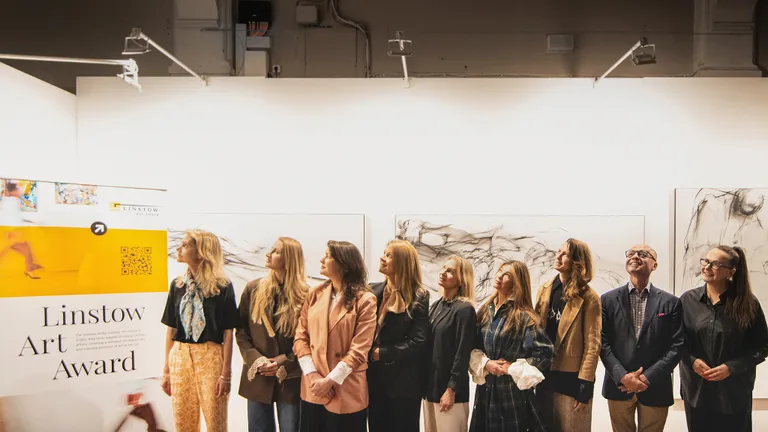
Paulina Rider Wilhelmsen with the international jury of the Linstow Art Award, the Rector of the Art Academy of Latvia Kristaps Zariņš, the Vice-Rector Antra Priede and the organisers. PHOTO: IEVA MAKARE
